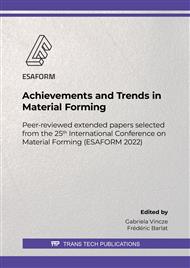[1]
A. Loupy, Microwaves in organic synthesis, Wiley-VCH, Germany, (2002).
Google Scholar
[2]
B. L. Hayes, Microwave Synthesis, Chemistry at the Speed of Light, CEM Publishing, U.S.A, (2002).
Google Scholar
[3]
S. Étienne et L. David, Introduction à la physique des polymères (in French), Dunod, Paris, (2002).
Google Scholar
[4]
Mark A. Janney & Hal D. Kimrey, Diffusion-Controlled Processes in Microwave-Fired Oxide Ceramics, Springer, MRS Online Proceedings Library, pp. MRS Online Proceedings Library 189, 215–227, 15 April (1990).
DOI: 10.1557/proc-189-215
Google Scholar
[5]
Kristen H. Brosnan Gary L. Messing Dinesh K. Agrawal, Microwave Sintering of Alumina at 2.45 GHz, Journal of the American Ceramic Society, pp. Volume 86, Issue 8, 1307–1312, 20 December (2004).
DOI: 10.1111/j.1151-2916.2003.tb03467.x
Google Scholar
[6]
D. M. Pozar, Microwave engineering, John wiley & sons Inc, USA, (2005).
Google Scholar
[7]
D. K. Cheng, Fileld and wave electromagnetics, Tsinghua University Press, (1989).
Google Scholar
[8]
D. B. Davidson, Computational electromagnetic for RF and microwave engineering, Cambrige University Press, New York, (2005).
Google Scholar
[9]
R. A. WALDRON, M.A., A.Inst.P., Perturbation theory of resonant cavities, The Institution of Electrical Engineers, Monograph No. 373 E, pp.272-275, 1959-1960.
Google Scholar
[10]
A. C. Metaxas et R.J. Meredith , Industrial microwave heating, The institution of engineering and technology, London, UK, (1988).
Google Scholar
[11]
J. D. Jackson, Classical Electrodynamics, John Wiley and sons Inc, 3rd ed., USA, (1998).
Google Scholar
[12]
K. Chang, Encyclopedia of RF and microwave engineering Vol.1-6, John Wiley & Sons, Inc, USA, (2005).
Google Scholar
[13]
Vadivambal, R. and D. S. Jayas, non-uniform Temperature Distribution during microwave Heating of Food and Bioprocess Technology 3(2): 161-171, (2010).
DOI: 10.1007/s11947-008-0136-0
Google Scholar
[14]
Salazar-Gonzalez, C., M. San Martin-Gonzalez, A. lopez-Malo and M. Sosa-Morales, Recent studies related to microwave processing of fluid foods, Food and Bioprocess Technology 5(1): 31-46 (2012).
DOI: 10.1007/s11947-011-0639-y
Google Scholar
[15]
N. Brahmia, P. Bourgin, M. Boutaous, D. Garcia, Numerical Simulation with Comsol Multiphysics of Crystallization Kinetics of Semi-Crystalline Polymer during Cooling: Application to Injection Moulding Process, Excerpt from the Proceedings of the Comsol Conference, Paris, (2006).
DOI: 10.1063/1.2740834
Google Scholar
[16]
S. Curet, F. Bellicanta Begnini, O. Rouaud, L. Boillereaux, Modeling Microwave Heating During Batch Processing of a Liquid Sample in a Single Mode Cavity, Excerpt from the Proceedings Comsol Conference in Grenoble, (2015).
Google Scholar
[17]
W. Klinbun and P. Rattanadecho, Investigation into heat transfer and fluid flow characteristics of liquid two-layer and emulsion in microwave processing, Elsevier, International Communications in Heat and Mass Transfer, p.115–126, (2015).
DOI: 10.1016/j.icheatmasstransfer.2015.12.005
Google Scholar
[18]
L.A. Campanone, N.E. Zaritzky, Mathematical analysis of microwave heating process, Elsevier, Journal of Food Engineering 69, 359–368, (2005).
DOI: 10.1016/j.jfoodeng.2004.08.027
Google Scholar


